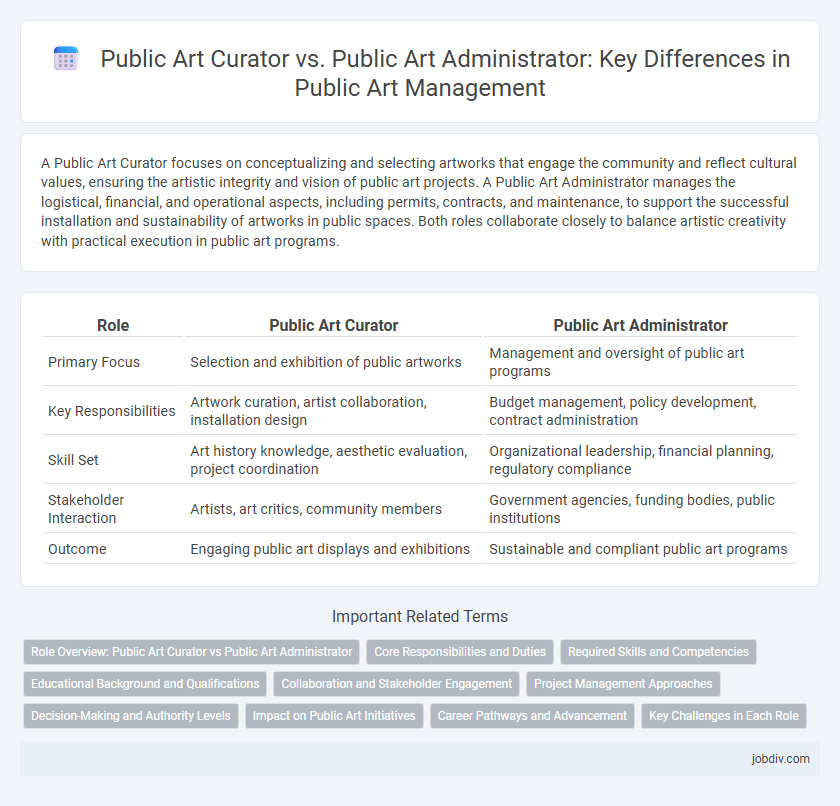A Public Art Curator focuses on conceptualizing and selecting artworks that engage the community and reflect cultural values, ensuring the artistic integrity and vision of public art projects. A Public Art Administrator manages the logistical, financial, and operational aspects, including permits, contracts, and maintenance, to support the successful installation and sustainability of artworks in public spaces. Both roles collaborate closely to balance artistic creativity with practical execution in public art programs.
Table of Comparison
| Role | Public Art Curator | Public Art Administrator |
|---|---|---|
| Primary Focus | Selection and exhibition of public artworks | Management and oversight of public art programs |
| Key Responsibilities | Artwork curation, artist collaboration, installation design | Budget management, policy development, contract administration |
| Skill Set | Art history knowledge, aesthetic evaluation, project coordination | Organizational leadership, financial planning, regulatory compliance |
| Stakeholder Interaction | Artists, art critics, community members | Government agencies, funding bodies, public institutions |
| Outcome | Engaging public art displays and exhibitions | Sustainable and compliant public art programs |
Role Overview: Public Art Curator vs Public Art Administrator
A Public Art Curator develops and manages artistic concepts, selects artists, and oversees the creative vision of public art projects to ensure cultural relevance and community engagement. A Public Art Administrator handles the organizational, financial, and logistical aspects, including contract management, budgeting, and regulatory compliance to facilitate smooth project execution. Both roles collaborate closely to balance artistic integrity with operational efficiency in public art initiatives.
Core Responsibilities and Duties
A Public Art Curator primarily focuses on the conceptual development, selection, and interpretation of artworks in public spaces, overseeing artistic vision and community engagement through exhibitions and programs. In contrast, a Public Art Administrator manages logistical and operational aspects, including budgeting, contract administration, permitting, and maintenance coordination to ensure project compliance and sustainability. Both roles collaborate closely to successfully implement public art initiatives, balancing creative goals with administrative efficiency.
Required Skills and Competencies
Public Art Curators require strong artistic vision, research capabilities, and expertise in art history to select and interpret works that engage diverse communities effectively. Public Art Administrators need exceptional project management, budgeting skills, and stakeholder coordination to oversee the logistical and operational aspects of public art programs. Both roles demand excellent communication, cultural sensitivity, and collaborative skills to successfully implement public art initiatives.
Educational Background and Qualifications
Public Art Curators typically hold advanced degrees in art history, fine arts, or curatorial studies, with specialized training in art theory, exhibition design, and community engagement. Public Art Administrators often possess qualifications in public administration, urban planning, or arts management, emphasizing skills in project coordination, budgeting, and policy implementation. Both roles benefit from experience in arts programming and knowledge of public art regulations, but curators prioritize artistic expertise while administrators focus on operational execution.
Collaboration and Stakeholder Engagement
Public Art Curators and Public Art Administrators collaborate by combining their expertise to enhance community engagement and ensure successful project outcomes. Curators focus on artistic vision and selection, while administrators manage logistics, budgets, and stakeholder communications. Effective collaboration involves regular dialogue with artists, local governments, and community members to align goals and foster inclusive public art initiatives.
Project Management Approaches
Public Art Curators emphasize creative vision and community engagement, selecting artworks that reflect cultural narratives and public interests. Public Art Administrators prioritize logistical coordination, budget management, and regulatory compliance to ensure timely project delivery. Effective project management in public art balances artistic innovation with operational efficiency to achieve impactful and sustainable installations.
Decision-Making and Authority Levels
A Public Art Curator concentrates on selecting, conceptualizing, and interpreting artworks, exercising creative decision-making authority in artistic direction and thematic coherence. In contrast, a Public Art Administrator manages budgets, permits, and stakeholder relations, holding operational authority to ensure projects comply with legal and logistical requirements. The curator's authority is rooted in artistic expertise, while the administrator's power is anchored in policy enforcement and resource management.
Impact on Public Art Initiatives
Public Art Curators directly influence public art initiatives by selecting, designing, and interpreting artworks that engage communities and reflect cultural values, enhancing the aesthetic and educational impact of public spaces. Public Art Administrators primarily manage the logistics, funding, permits, and stakeholder coordination essential for the successful implementation and sustainability of public art projects. Their collaboration ensures public art initiatives are both visionary and feasible, balancing creative goals with practical execution.
Career Pathways and Advancement
Public Art Curators typically advance by developing expertise in art history, exhibition design, and artist collaboration, often progressing from assistant roles to senior curatorial positions or museum directorships. Public Art Administrators focus on project management, funding acquisition, and community engagement, with career growth linked to success in overseeing large-scale public installations and securing grants. Both pathways offer opportunities in cultural institutions, municipal agencies, and nonprofit organizations, with advancement depending on specialized skills and network development within the public art sector.
Key Challenges in Each Role
Public Art Curators face key challenges in conceptualizing and selecting artworks that resonate with diverse communities while balancing aesthetic vision with public engagement. Public Art Administrators encounter difficulties in securing funding, navigating bureaucratic regulations, and managing logistics to ensure timely project completion. Both roles must address stakeholder collaboration complexities, but curators emphasize artistic integrity whereas administrators prioritize operational efficiency.
Public Art Curator vs Public Art Administrator Infographic

 jobdiv.com
jobdiv.com